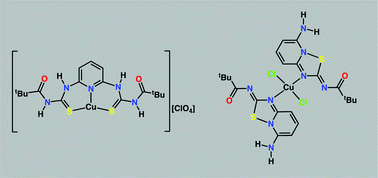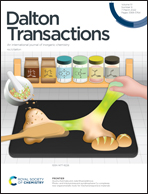N,N′-Substituted thioureas and their metal complexes: syntheses, structures and electronic properties†
Abstract
The synthesis of six N,N′-substituted thiourea ligands (L1a–L3b) was achieved in two steps. A corresponding extensive series of Cu(I), Cu(II), Ni(II) and Zn(II) complexes (1–24) with varying formulations were synthesised from these ligands by the reaction of a 1 : 1 or a 1 : 2 mixture of Cu(II), Ni(II) and Zn(II) perchlorate or chloride salts. Complexes 1–24 have been comprehensively characterised by mass spectrometry, elemental analysis, UV-vis., IR, and 1H and 13C{1H} NMR spectroscopies where applicable. The X-ray crystal structures were obtained for eight examples: [(L1a)2Cu]ClO4 (1), [(L1c)2Zn](ClO4)2 (4), [(L2a)2Cu]ClO4 (6), [(L2c)2Ni](ClO4)2 (7), [(L1b)2Cu](ClO4) (15), [(L1b)CuCl] (16), [(L4)2CuCl2] (19) and [(L3b)CuClO4] (21). These studies reveal that L1c and L2c represent ligands that have undergone cleavage during reaction with the metal salt; L4 represents an intramolecular rearrangement (via a Hugershoff reaction) of L2b; and in most cases Cu(II) is reduced to Cu(I) during the ligand reaction. The X-ray crystal structures also reveal that 1, 4, 6, 15 and 16 are monometallic species in the solid state; that Cu(I) in 1, 6, 15 and 16 and Zn(II) in 4 are arranged in a distorted tetrahedral geometry; that Cu(I) in 21 adopts a trigonal planar geometry; and that in 7 and 19 the Ni(II) and Cu(II) centres, respectively, possess square planar geometry. Preliminary studies on the biological activity (using the Malaria Sybr Green I Fluorescence assay) of the thiourea containing complexes suggests that the d10 complexes, and increased ligand stoichiometries, may afford higher potency.



 Please wait while we load your content...
Please wait while we load your content...